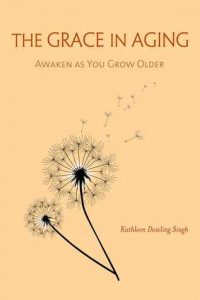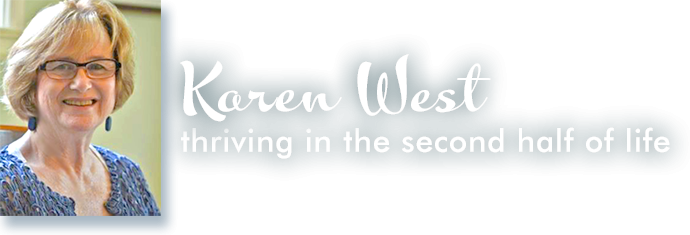In my last blog entry, I wrote that one of the hallmarks of the transition from adulthood to elderhood is feeling a desire to slow down, to take some time away from constant doing, and feeling a desire to spend more time being, more time looking inward. But the idea of “slowing down” is anathema to many aging people. In fact, the phrase “slowing down” is often used when we want to call attention to and to bemoan the fact that someone is noticeably aging.
But is “slowing down” really such a bad thing? In his book Second Wind: Navigating the Passage to a Slower, Deeper, and More Connected Life, Bill Thomas devotes a whole chapter called “Slow” to encouraging us to rethink our desire for speed, for “productivity,” at the expense of time for reflection and for being more mindful of how we are spending our time. Thomas writes: “Beginning the journey into elderhood is good for us because it leads us toward the unique sources of meaning and purpose that are available only to those who are willing to live slow.” (201–202)
Happily, more and more people are realizing that they don’t want to or have to be the person they were at 40 or 50 when they are 60 or 70. They are realizing that Rabbi Zalman Schachter-Shalomi was right when he wrote that old age can be a time of “self-development and spiritual growth.” (From Age-ing to Sage-ing, 5)
 In my favorite book about aging, The Grace in Aging: Awaken as You Grow Older by Kathleen Dowling Singh, she calls this slowing down “withdrawal.” In my classes, when I share Singh’s concept of “withdrawal,” often there is someone who vehemently rejects this idea. In one of my classes, it was a 90-year-old man.
In my favorite book about aging, The Grace in Aging: Awaken as You Grow Older by Kathleen Dowling Singh, she calls this slowing down “withdrawal.” In my classes, when I share Singh’s concept of “withdrawal,” often there is someone who vehemently rejects this idea. In one of my classes, it was a 90-year-old man.
Singh says that slowing down or “withdrawal” is what happens when someone worsens after being diagnosed with a terminal illness. A person withdraws or disengages “from busy-ness and its worldly, mindless persona.” She says this is also one of the opportunities that aging offers us, but because the withdrawal is “less extreme, less dramatic, less urgent” than a bad diagnosis is, we can miss it.
However, she says that if we take advantage of this opportunity to live “with less frenzy to obscure our mindfulness, we are left with a more naked view of ourselves.” We can slow down “enough for some keen observation. It’s time, if we so choose, to fully make our own acquaintance, without the overlay of younger urges and midlife constraints and demands and schedules…This withdrawal offers us an opportunity to stop in our tracks, to halt in the rush of our headlong forward movement, and examine who we are and what we’re doing.” (104)
In Conscious Living, Conscious Aging, Ron Pevny calls this moving into elderhood a “hero’s journey.” Pevny also refers to the 3‑stage transition process that William Bridges wrote about in his book Transitions (see my blog entry #2 “Making a Transition”). After the first stage—letting go of “who you have been in midlife adulthood”—you enter the “neutral zone.” In this stage, he says, “You may experience grief as you continue letting go of elements of your former identity while facing the fear that a new identity, a new sense of self and purpose, will never emerge…As challenging as this phase may be, it is the necessary doorway to a new life chapter. In the neutral zone, the vision, creativity, strength, and spiritual connection that will define your elderhood will begin to emerge.” (26–27)
And as Rabbi Zalman suggests in the second chapter of his book From Age-ing to Sage-ing called “Becoming the Possible Sage,” growing into this new identity as an elder can also enable the older person to contribute to the world. He quotes Pir Vilayat Inayat Khan, head of the Sufi Order of the West, who said, “If you don’t know that you can be a new person, you will continue dragging your old self-image into the brave new world. You will be outrun and pronounced redundant, unable to make a contribution to the inexorable advance of evolution on our planet.” (49) What a shame that would be.


5 thoughts on “Choosing to “fully make our own acquaintance””
I have been feeling the urge to slow down in the last few years. For me it’s not a withdrawal from the world, but rather a ‘waking up’ to it. It’s taking the time to really see the amazing world around us and savor the experiences we have, rather than rush through them trying to pack as much in as time allows.
Thank you so much for your comment, Cheryl. I love what you said about “waking up,” and “really seeing” and “savoring.” I think that is what we are more able to do when we “slow down” and pay attention rather than always being busy.
It is nice to slow down and really get to know thyself. I have decided I like myself more now than ever before. I even think now I am beautiful and not the ugly duckling I always thought I was. I now have time for me after spending so many years for my family.
Thank you so much for your reply, Joan, and thank you for sharing your experience of feeling beautiful as you have more time to get to know yourself. I hope you will share some more comments in the future!
I really appreciate your comment, Joan. I’m so happy slowing down has helped you to see your beauty. I hope you continue to read and comment on my blog!